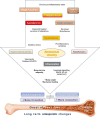Fracture Risk Assessment in Metabolic Syndrome in Terms of Secondary Osteoporosis Potential. A Narrative Review
- PMID: 39979438
- PMCID: PMC11842537
- DOI: 10.1007/s00223-025-01341-5
Fracture Risk Assessment in Metabolic Syndrome in Terms of Secondary Osteoporosis Potential. A Narrative Review
Abstract
Osteoporosis is a major global public health problem with the associated bone fractures contributing significantly to both morbidity and mortality. In many countries, osteoporotic fractures will affect one in three women and one in five men over the age of 50. Similarly, diabetes, obesity, and metabolic syndrome (MetS) are among the leading public health problems due to their worldwide prevalence and burden on health budgets. Although seemingly disparate, metabolic disorders are known to affect bone health, and the interaction between fat and bone tissue is increasingly well understood. For example, it is now well established that diabetes mellitus (both type 1 and 2) is associated with fracture risk. In this narrative review, we focus on the potential link between MetS and bone health as expressed by bone mineral density and fracture risk. This narrative review demonstrates the association of MetS and its components with increased fracture risk, and also highlights the need for fracture risk assessment in patients with obesity and MetS.
Keywords: Fracture risk assessment; Hyperglycemia; Insulin resistance; Metabolic syndrome; Obesity; Secondary osteoporosis.
© 2025. The Author(s).
Conflict of interest statement
Declarations. Conflict of interest: Authors FA and EVM declare that they have no conflict of interest. Ethical approval: Not applicable.
Figures


Similar articles
-
Insulin resistance, bone health, and fracture risk.Osteoporos Int. 2024 Nov;35(11):1909-1917. doi: 10.1007/s00198-024-07227-w. Epub 2024 Sep 12. Osteoporos Int. 2024. PMID: 39264439 Review.
-
Positive association between metabolic syndrome and bone mineral density among Malaysians.Int J Med Sci. 2020 Sep 16;17(16):2585-2593. doi: 10.7150/ijms.49030. eCollection 2020. Int J Med Sci. 2020. PMID: 33029101 Free PMC article.
-
Osteoporosis epidemiology 2013: implications for diagnosis, risk assessment, and treatment.Curr Opin Rheumatol. 2014 Jul;26(4):440-6. doi: 10.1097/BOR.0000000000000064. Curr Opin Rheumatol. 2014. PMID: 24807402 Review.
-
Fracture risk and assessment in adults with cancer.Osteoporos Int. 2023 Mar;34(3):449-466. doi: 10.1007/s00198-022-06631-4. Epub 2022 Dec 13. Osteoporos Int. 2023. PMID: 36512057 Review.
-
Waist circumference, among metabolic syndrome components, predicts degraded trabecular bone score: a retrospective study of a female population from the 2005-2008 NHANES cohorts.Front Endocrinol (Lausanne). 2024 Nov 21;15:1476751. doi: 10.3389/fendo.2024.1476751. eCollection 2024. Front Endocrinol (Lausanne). 2024. PMID: 39640886 Free PMC article.
Cited by
-
Association between age-related macular degeneration and osteoporosis in US.Sci Rep. 2025 Aug 8;15(1):29045. doi: 10.1038/s41598-025-13959-4. Sci Rep. 2025. PMID: 40781266 Free PMC article.
-
10-Year Fracture Risk Assessment with Novel Adjustment (FRAXplus): Type 2 Diabetic Sample-Focused Analysis.Diagnostics (Basel). 2025 Jul 29;15(15):1899. doi: 10.3390/diagnostics15151899. Diagnostics (Basel). 2025. PMID: 40804864 Free PMC article.
References
-
- Third Report of the National Cholesterol Education Program (NCEP) (2002) Expert panel on detection, evaluation, and treatment of high blood cholesterol in adults (adult treatment panel III) final report. Circulation 106:3143–3143 - PubMed
-
- Ebeling PR, Nguyen HH, Aleksova J, Vincent AJ, Wong P, Milat F (2021) Secondary osteoporosis. Endocr Rev 43:240–313 - PubMed
-
- Kanis J.A. on behalf of the WHO Scientific Group (2008) Assessment of osteoporosis at the primary health-care level. Technical Report. WHO Collaborating Centre, University of Sheffield, UK, Sheffield.
-
- Noubiap JJ, Nansseu JR, Lontchi-Yimagou E et al (2022) Geographic distribution of metabolic syndrome and its components in the general adult population: a meta-analysis of global data from 28 million individuals. Diabetes Res Clin Pract 188:109924 - PubMed
Publication types
MeSH terms
LinkOut - more resources
Full Text Sources
Medical

